The Professional Webspace of Designer and Illustrator Kevin Cornell:
"Design, Art, and Lackluster Humor."
Paper For Your Tools
There's a lot of paper choices out there. A lot. And I'm not even counting weird non-artistic paper, like wax paper or wall paper. Yet I still haven't found the perfect paper. Each paper, has its advantages, and its disadvantages. As the old saying goes, you can't have your cake and eat it to. Not that you'd want to eat your paper. Well, except rice paper.
Anyway...
In these past three Bear Tools installments, I've spoken about what you're drawing or painting with, but not necessarily what you're drawing on. With that in mind, I think I'd like to go over those tools again, but this time list what kind of paper I'd use with them.
Paper for Roughs
Nearly every time I'm created a pencil rough, I'm using plain, old, easy-to-find computer paper. Part of this is because I do such a vast amount of rough drawing that to try and limit myself to using only drawing paper would bankrupt me. Another reason is purely psychological; a piece of crappy computer paper is a lot less intimidating than a spankin' new sketchbook. So I fucked up — big deal. Throw it in the bin and start again. And still yet another reason for using computer paper is that it's thin enough for tracing (without a lightboard) should the situation call for it1.
But, as I mentioned, each paper comes with its drawbacks, and a major drawback of this stuff is that it's probably not going to last 100 years. I do buy acid-free computer paper, but even so, it's just not the most sturdy of stocks. But time will tell.
Paper for Pen & Ink
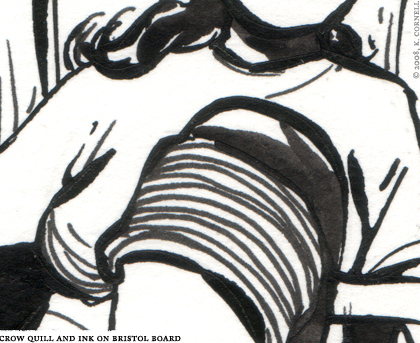
For situations where I'm using a Crow Quill Pen and ink, I almost always stick to 100 lb. Vellum Bristol Board. The smooth, but not-too-smooth texture is optimal for line-making, and it's thick and durable enough to prevent bleeding or tearing of the paper. Yet still thin enough so that, with a good lightboard or a big window on a sunny day, I can place my rough underneath and lightly transfer the image in pencil.
The only drawback in this case is that when there's a lot of washing or brushing of black, the paper might warp, and warping makes scanning and framing much tougher. But to be honest, this is more of a problem I run into with painting.
For situations where I'm using a Micron, or a Rapidograph, again Bristol Board would be my paper of choice, were I planning to frame or display the art. But in most cases, if I need to draw with a Micron, it's for comics like Ambidextrous or Mojo; and those are done on computer paper, with frames pre-xeroxed for my own convenience.
Otherwise, if I'm using one of these pens, I'm probably drawing in a sketchbook (which I'll address down below). Really, all I need to make sure of when I'm choosing paper for these sort of pens is that the paper doesn't bleed excessively. So I can safely say that napkins and paper towels will never be my paper of choice.
Drawbacks? Why, the same ones I face when I do roughs. No guarantee of longevity. Someday, perhaps, I'll find a xerox machine that I can run Bristol Board through, but for now, I'll just have to make due.
Paper for Painting
Okay... here's where paper choices seem to explode. It's also where I experience the greatest tug-of-war between pros and cons. I think for this section, It'd be easier to list the papers I've used, and share the advantages and disadvantages. Now, if you remember, I work almost exclusively in watercolor and gouache, so these materials all are suited for those two painting mediums. If you want to work in oils or acrylics... I can't help you.
Hot Press Watercolor Paper
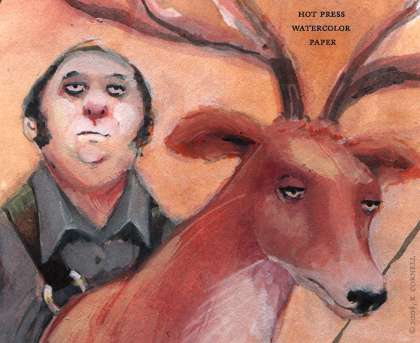
There's three species of watercolor paper out there: Hot Press, Cold Press, and Rough. Hot press paper has a smoothest surface of these three species. I prefer a smoother surface, because it allows me to add more detail per inch of picture. Also, hot press paper tends not to "soak up" the paint as readily, making it easier for me to build up layers of gouache.
But that's not all to consider with watercolor paper, because one also must contemplate the paper's weight. At least at my local art stores, there's pretty much three options: 90, 140, and 300 lb. paper. What's important to understand here is that as the weight increases, the smoothness of the surface decreases. So here's where the balancing act starts. On one hand, the 90 lb. lets me add the most detail, allows for easy transferral of the rough, and lets me build gouache up the easiest. But, that lighter, thinner weight means a greater chance of the paper warping2, which means it's harder to frame, and harder to scan3. Also, after a certain point, paper can become so warped it gets difficult to even continue painting. The 140 lb., as you probably guessed, is less prone to warping, but its surface is rougher. And to be honest, it still warps way more than I want.
So that leaves me with the 300 lb. Hot Press. Which actually is a pretty good compromise. The surface is rough, but less so than the cold press or rough press, so I can still get in enough detail to be happy; yet the paper is durable enough that it survives warping, and is easy to frame.
Cold Press Watercolor Paper
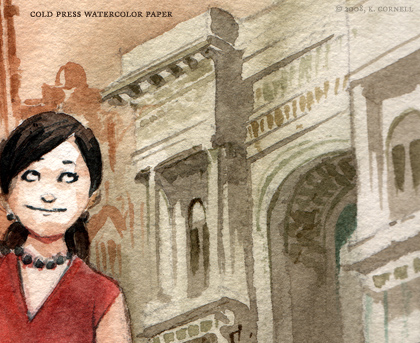
So after getting the skinny on Hot Press, you should already have a pretty good idea of what Cold Press Watercolor Paper has to offer. It's got a rougher surface; so if detail is your thing, you might want to steer clear. But, in many instances, you might really want to have that rough texture prevalent throughout the painting (it does lend itself to more traditional "suggestive" watercolor landscapes), so maybe this is an option to consider. Again, you'll have three weights to choose from, each with their drawbacks with regard to surface smoothness and durability.
With regards to Rough paper, I don't have anything worth saying. In my mind it's pretty much Cold Press paper that's even more rough. I really can't remember ever using it. Maybe someday, if I need to sand my elbows.
Illustration Board
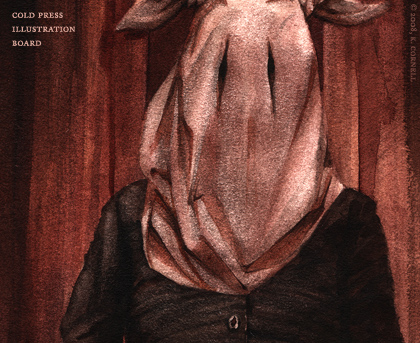
Another common paper I'll use isn't exactly a paper. Illustration Board is sort of like a cross between paper and heavy cardboard. Suffice it to say, it's got 90 lb. watercolor paper utterly whooped when it comes to durability.
Much like watercolor paper, with Illustration Board you have Hot Press and Cold Press options. Now, in an curious twist of fate, Hot Press is the option I avoid. It's too smooth. At least for my taste. Like Colt 45. I'm not sure what medium it's for, anyway. The "Ice Skate" perhaps.
Cold Press Illustration Board, however, is perfect, at least for what I want to achieve. The way it soaks up washes, the texture it creates, the ease with which I can build up gouache layers; it's just a treat to use. The only drawback is that I can't use a lightboard to transfer the rough. Instead, I need to print out the rough, draw on the reverse side in a soft graphite (tracing the important outlines and visual landmarks) then place it on the illustration board so that the graphite side is down, and then rub it onto the illustration board to leave a light copy. Then I can pencil again, using the rubbed outline as a guide. So... yeah. It gets kinda tedious.
One other thing to note about Cold Press Illustration Board, is that I prefer to use the "double-thick" board. The single-thickness board can still curdle a bit. Like Colt 45 with milk.
Sketchbooks
I have, over the years, invested a great deal of time and money in sketchbooks. I sort of lump sketchbooks into two categories. On one hand there's sketchbooks that one keeps in the studio or desk, for planning paintings or fleshing out concepts. 9"×12" sort of things, or maybe even 11"×14". Lots of room. Then, on the other hand, there's sketchbooks that one plans to carry around with them everywhere. More of travel journal — the sketchbook equivalent of a camera, for quick snapshots or for capturing ideas on-the-spot.
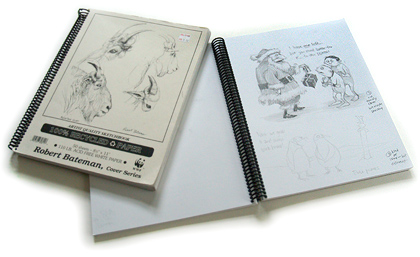
With regards to the first category, the at-home book, I don't have too much to say. I really only try to meet two requirements: that it's recycled paper, and that it's acid-free. These aren't hard requirements to hit, and they have little to do with artistic preference. However, there is one brand of book that works particularly well with my rough drawing method. So consequently I'm a big fan of the Robert Bateman Recycled Sketchbooks.
With regards to the second category, the take-me-places book, I'll share my findings. But first, I have to break the sad news that I can no longer find the "Sketchbook One"-style sketchbook. I bought it initially at Barnes & Noble around 2001, and saw them around for a couple years, but they no longer seem to be available. And since I threw out the wrapping, I really can't remember the manufacturer. It might have been something like... Equis. But other than that I can't remember. Sorry.
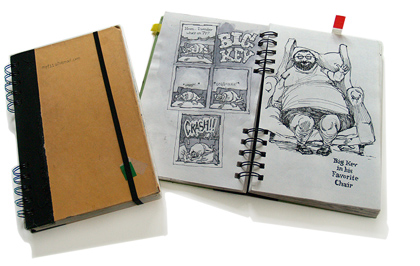
A good brunt of my sketchbook collection is made up of Cachet Wirebound Journals, the 5¼ × 8¼ size. I find the book to be sturdy, the paper to be of fine tooth acceptable for pen and pencil. It's durable enough that I could draw on both sides with only minimal ghosting. It can even tolerate a little watercolor washing, though really not too much (and the paper will most certainly warp).
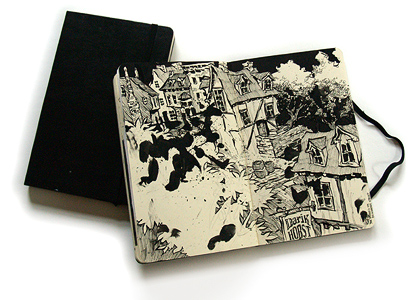
Not counting random boutique-manufactured sketchbooks I've bought here and there, the majority of my sketchbooks are Moleskines. Of those, I've found the Moleskine Sketchbook to be somewhat ill-suited to how I draw. The paper is too smooth, and has a waxy coating that makes Micron lines sort of grey out, and makes watercolor washes impossible. Rapidograph lines have yet to be tested, but I suspect they'll work okay. I will say they're fantastic for Crow Quill drawings — however I do advise spray-fixing the drawing when you're done, as it will tend to leave black bits on the opposing page (or drawing).
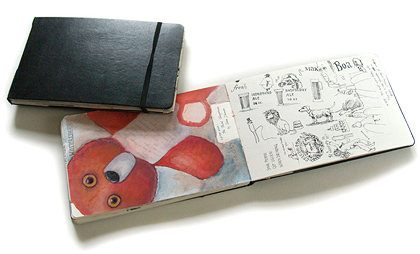
Now, while I don't have any strong attachment to Moleskine's normal sketchbook, their Watercolor Sketchbook is definitely my favorite choice of any sketchbook. The paper weight is heavy enough to minimize warping, and all my chosen mediums — pencil, pen, crow quill, watercolor, and gouache — look handsome on its pages. It opens flat, so it's easy to draw even down into the binding (of course, this is a feature of all Moleskines, and even the Cachet Journals above can do something similar), making it easier to scan. Just about the only drawback to these is that the most manageably-sized one only comes in landscape format. I'm just a portrait type of guy I guess.
Untested Options
Now, while I haven't tried every sketchbook out there, I've at least gone to the trouble of bookmarking one or two of the interesting options I come across, for trial later. Perhaps some of these might float your boat. Or perhaps they've already floated it and now you can share your findings:
Bear Tools: The End
Okay! So that concludes this little series about the tools I use day-to-day. Of course, everyone has different preferences, and I can safely say my choices aren't always suited to everyone. But, for someone looking for a place to start, hopefully this was helpful. And hell, if you paid close attention and read between the lines, there's probably a lot of technique revealed in these past four articles4. But I have to say I'm glad to have finished. I've been standing in front of this table for close to a month, and none of these tools in front of me were edible.
I think I'll catch a quick 40 winks in the barn. Tah!
footnotes
1 One important thing to remember here is that I am a commercial artist rather than a fine artist. And while I do value the creation of compelling original art, my final "goal" is almost always an image on the web or in print. So, someone with more of a fine artist bent may not want to sacrifice the quality of their original art for speed, or for a better quality reproduction, like I often do.
2 Of course, warping can be avoided by stretching your watercolor paper. I haven't done this in years, mainly because... well... I'm too impatient for it. That, and extensive preparation of any canvas can often lead to cold feet when it comes time to paint. You get that... "I just spent forever stretching this thing... I better save it for a masterpiece". And then you go off and plan your masterpiece. And then you lose interest because you didn't capitalize on the painting when you were excited about it. So I'm not saying don't stretch your canvas — but I can certainly understand if you don't want to.
3 One aspect I always have to keep in mind when planning a painting is making sure it's a scannable size. Not that you can't scan in a large painting in pieces (I've had to do this quite a few times), but that requires some serious Photoshopping skill and time. So it pays to make sure your paper fits on your scanner before you start.
4 I'm not a big supporter of creating tutorials or revealing technique. I suppose in some instances it's helpful, but for the most part I think it's better to try and figure out someone else's technique yourself. For one thing, you end up learning way more stuff because you're trying new things and testing new methods. And for another, mimicking exactly how someone works means you're not exploring your own style to the fullest. But I'm sure others share differing opinions.
Comments on this Article
There are currently 16 comments.
2. bearskinrug
Welllity....
The Hot Press Watercolor image is Puppedeer, but the "Big Kev" is appearing for the first time. At least here.
3. Junkyard Sam
What an excellent entry! I really enjoyed reading about your paper types.
As far as sharing tutorials or methodology - I wouldn't worry so much. Any serious artists that see such things probably use them more as a point of interest than something to rip from. They make very interesting reading.
Thanks for this post.
4. Lucero
I wonder if you try this, but once upon a time in my highschool life. I drew a few Illustrations using crayons and ordinary paper, I soaked with with water and dried it up under the sun for not so many days... For me, it's good though on how the crayons and the paper match together. I don't know if it's just luck or something. Well, that's my school project. That's the first and last time that I've do something like that.
Anyways, Thanks for this great article!
5. Ian
Excellent articles, sir! Very thorough! Very detailed!
I appreciate you including Big Kev. I was beginning to think he was only a figment of my imagination.
6. Phyllis
Fabulous, as always! I do most everything digitaly now, but I still love returning to that tactile world of paper. My kids don't enjoy it, only because it's not unusual to find me standing in the art store, poring over a single sheet of paper for twenty minutes. :-)
I've never seen a drawing tutorial, but I don't really want to. It would be a little like a tutorial of someone getting dressed in the morning. I have my own methods and it doesn't much matter to me how you hold your pencils and brushes, just as much as it doesn't matter which garment you start with when you get dressed. There's enough information in the Bear Tools series to inspire, the best kind of tutorial there is! :-) Thanks for sharing your tools and your work, I've truly enjoyed it!
7. jujueyeballs
For a minute there, I thought my browser was broken 'coz I wasn't seeing any detail.
Anywhoo, topnotch writing as always Mr. Cornell!
8. bearskinrug
Junkyard Sam - Good point, sam - thanks!
Lucero - That sounds like an interesting project - I'm assuming the crayon was supposed to melt a little in the sun? Why wet the paper?
Ian - There's an excellent Big Kev stowed away in one of Stan's sketchbooks. That one is like a mirror in the future!
Phyllis - Well, in terms of art garments I wear, I'm exclusively a Mumu man.
Juju - Hoozah! Thanks :)
9. Catherine
These are fantastic writeups, and I'm learning so much. Thank you for posting these!
Do you take suggestions for topics to cover? I'm just starting to be more prolific with my comics, and I don't know how best to store the art that is rapidly piling up. I'm curious if you have any advice for archiving your artwork for the long-term.
10. Nary
Kevin, you are genius. I love love love the paper cut-out illustration. All that texture! Thanks for a fun and informative entry with plenty of eye-candy for my Monday morning.
Oh, and the bit w/Mojo thrusting his loins is priceless and engraved in my mind f-o-r-e-v-e-r.
11. niff
Don't know if someone has saved your day yet or not, BUT:
That's where you can find em!
:)
13. bearskinrug
Catherine - Hmmm - well, I don't know if I'm qualified for that article! I myself have quite the build up of comics and no where to put them. I WILL say that if you have to store anything in a basement, to put it in a plastic bin, and take whatever precautions you'll need to protect it from direct sunlight or heavy humidity.
Nary - Awwww - you just made Mojo's day! ;)
Niffaroo - Haha - I thought that was a little odd. But the thought occurs to me that if SOMEONE could track down those sketchbooks, it COULD be you :D
14. Phyllis
Mumus rock! Personally, though, I prefer floppy jammies.
Seeing your work always makes me wish I had more time to do some real drawing and painting again. *sigh* One day!
15. Bananaglyph
Sh-e-e-e-t! Can you at least WARN me when you're going to throw The Prowler in there!? Scroll, read, scroll, read, scroll... SHRIEK!

[ Back to Top ]
Search Bearskinrug:


Other Sections You Might Want To Visit:
- The Downloads Section: Wallpapers for the Discerning Desktop.
- The Links Archive: A Collection of Interesting Tidbits.












1. Manuel Martensen
Loved the details in the “Hotpress watercolor paper” clipping. And the “Big Kev”!
Is that an unpublished one?